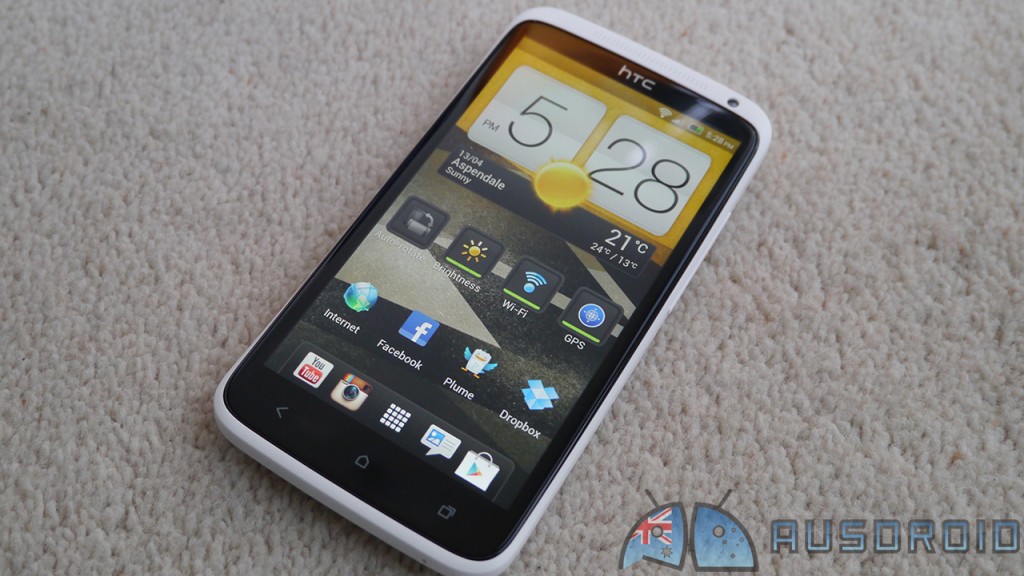
The same HTC but with a lot more common ‘Sense’
In 2011 HTC got really excited about releasing their Sensation phone, however in light of what Motorola and Samsung were doing with their Dual-Core offerings in that year, this phone fell short of the calibre of 2011 devices. Despite the Sensation not quite being the beast that it should have, HTC persisted and released a few more Sensation branded devices that would boast that extra oompf that the original Sensation wasn’t able to deliver. At the end of last year HTC were reporting lower than expected fiscal performance, this didn’t surprise any of us here at Ausdroid. Peter Chow, CEO of HTC went on record to say that HTC would rein in the number of devices in their portfolio and would focus on a core brand, that brand is now the HTC One range of devices.
The HTC One X was the cream of the crop at the Mobile World Congress earlier this year. This is great news for HTC, but we should also make a quick note that there were no flagship entries at MWC from Samsung, Motorola or Sony, so other than LG’s announcement of the 4X, HTC had the floor.
At MWC HTC début the One X, which would be the first publicly available quad-core smartphone on the market. HTC made sure to also mention, that it was a less bloaty and nimbler version of their custom skin HTC Sense and it would run on top of Android 4.0.
The device has 3 dedicated hardware buttons, power, volume up and volume down. It also has 3 soft keys, back, home and recent apps. When the device opens an app that still uses the old menu key it gives you a black band with the menu button on screen which is reminiscent of the on screen keys from the Galaxy Nexus configuration. It looks silly at first, but you get used to it and it doesn’t take any more screen real estate than what would be present on the Galaxy Nexus. The overall build quality of the device is solid, soft and visually pleasing.
The telephony quality is great, with the phone being HD Voice capable out of the box. Data speeds are what you’d expect of any HSDPA+ phone on the market at the moment, however there appear to be a few times that calls don’t connect the first time.
The LCD2 screen on the One X is a huge selling point. Samsung with it’s Super AMOLED HD seemed to indicate that AMOLED was the best screen technology for smartphone’s, but the LCD2 screen quality is sharp, detailed and superiorly more visible in daylight. Its colours are a little more subtle than on a Super AMOLED display but this makes it feel more true to real life.
HTC chose to mod ICS with their HTC Sense 4.0 skin, but have gone for a much more minimalist approach than their previous iterations of Sense. The personalisation options of the HTC are great, whether you want to change the way the desktop looks with ‘Scenes’ or the look of the menus an layouts with ‘skins’ or even modify the lockscreen, HTC has you covered.
The overall feel of the software is smooth and fast, but does feel a bit hindered considering that it is quad-core processor in the phone. The phone is able to run anything you throw at it with relative ease and being a Tegra device you have access to all the intensive graphics games that nVidia has pushed developers to make. The only draw back is that now games are getting bigger there is less available RAM and it only takes 2 or 3 somewhat intensive apps to be open for Android’s native task killer to close something, thus forcing you to wait for a game to load again.
Sense has been greatly improved on the One X, but this doesn’t change the fact that it interrupts the elegance, style and fast feeling performance of stock Ice Cream Sandwich. There are no neon glows through the system and the Roboto font which was beautifully implemented by Google to highlight HD screens is also gone. Sense will also occasionally crash which means you have to wait for your desktop to load again before going to your apps and the included Sense widgets will also flicker in unusual ways.
The Recent Apps option feels heavier than it should, rather than getting a vertical band of 3 or 4 open apps that you can see thumbnails of, HTC turned it into a carousel or conveyerbelt that only comfortably shows one app and the edges of others on the left or right, which means you have to flick through them before opening them or flicking them up to close them.
The battery on this phone sucks! It is one of the worst batteries I’ve ever experienced on an Android phone. It will get you maybe 10-12 hours of light to medium use, but once you get that quad-core processor going it’s game over after 5 or so hours. This is actually something HTC is aware of and that they are comfortable people will be ok with… what?!? really?!?
The HTC One X can also get a little hot when playing games, this is normally disconcerting thing when your phone starts to warm up your hands, but since ‘Winter is coming…’ this might in turn work in the users favour. The real problem here is that when you feel the phone warm up, you can also see the direct relationship with the battery drain.
[nggallery id=124]
[nggallery id=125]
Specs..
- Android 4.0.3
- 1.5GHz nVidia Tegra3 Quad-Core CPU
- 4.7-inch 1280×720 (312ppi) LCD2 Display
- 134.4 x 69.9 x 8.9 mm
- 130 grams
- 8MP / 1.3MP cameras
- 32GB Internal Memory
- 21Mbps HSPA 850/900/1900/2100MHz
- 1800mAh battery
- NFC
Despite the HTC One X rocking Sense 4.0 and having a somewhat shitty battery life, it is definitely a device I’m happy to call my own and have not regretted moving from my Galaxy Nexus for it. The phone looks good, feels great and runs amazingly fast. That being said though, once the modding community gets some customs roms out for it, I know I’ll jump ship from Sense and try out CyanogenMod 9 or AOKP.
For an everyday user, I have no doubt they will love this phone immensely. HTC put a lot of effort into getting this phone right and it shows in every way you can use it, it’s almost like it was built with love.
The HTC One X is also available from Optus ($60 plan), Vodafone ($59 plan), Virgin ($59 plan) and out right from Allphones ($658). We should also see it’s brother from another mother (HTC One XL) come to Telstra in the coming months with the 4G frequency included.









